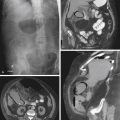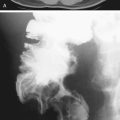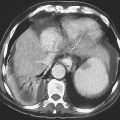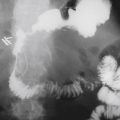CASE 151
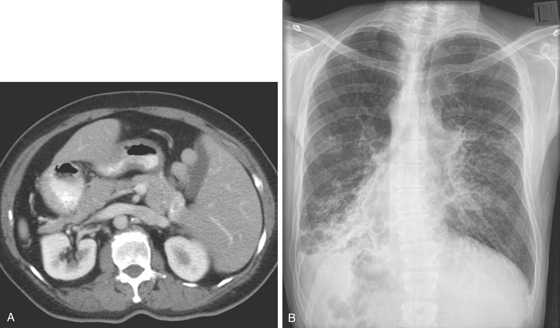
History: A 47-year-old man presents with abdominal pain.
1. What should be included in the differential diagnosis of the imaging finding shown in Figure A? (Choose all that apply.)
2. Chest x-ray shows dextrocardia and right lower lobe bronchiectasis. What chronic disease does this patient have?
3. What is the most serious disease associated with situs ambiguus (heterotaxy syndrome)?
4. Which of the following statements regarding situs inversus is true?
B. The incidence of congenital heart disease in patients with situs inversus is about 5%.
C. The underlying condition causing situs inversus is primary ciliary dyskinesia.
D. Prevalence of Kartagener’s syndrome is about 1 in 10,000.
ANSWERS
CASE 151
Situs Inversus
1. C and E
2. C
3. B
4. B
References
Applegate KE, Goske MJ, Pierce G, et al: Situs revisited: imaging of the heterotaxy syndrome. Radiographics. 1999;19(4):837–852.
Cross-Reference
Gastrointestinal Imaging: THE REQUISITES, 3rd ed, p 146.
Comment
The reverse of the normal arrangement of organs in the chest and abdomen (situs solitus) is called situs inversus and sometimes situs ambiguus, although situs ambiguus (heterotaxy) is usually reserved for conditions that fall outside the mere orderly mirror arrangement of situs inversus, such as seen in this patient (see figures). Situs ambiguus would include an array of anomalies that may or may not be present in any predictable frequency, such as discontinuous inferior vena cava, azygos continuation, and common or shared trunk for the celiac and superior mesenteric arteries. Situs ambiguus can also occur with asplenia, and these patients have an extremely high incidence of congenital heart disease (85% to 95%); situs ambiguus is more commonly seen in pediatric patients. The other main division of situs ambiguus is situs ambiguus with polysplenia. The incidence of heart disease is much lower. Most of these patients have levocardia. This patient has dextrocardia (see figures).
Situs ambiguus with asplenia is almost universally associated with some form of congenital heart disease and is uncommon in adults. This probably relates to the high mortality of situs ambiguus and asplenia in infancy. Situs ambiguus with polysplenia may be an asymptomatic condition if not associated with a congenital cardiac defect. The organ arrangement may be an incidental discovery. Occasionally these patients are referred for vague abdominal pain.


